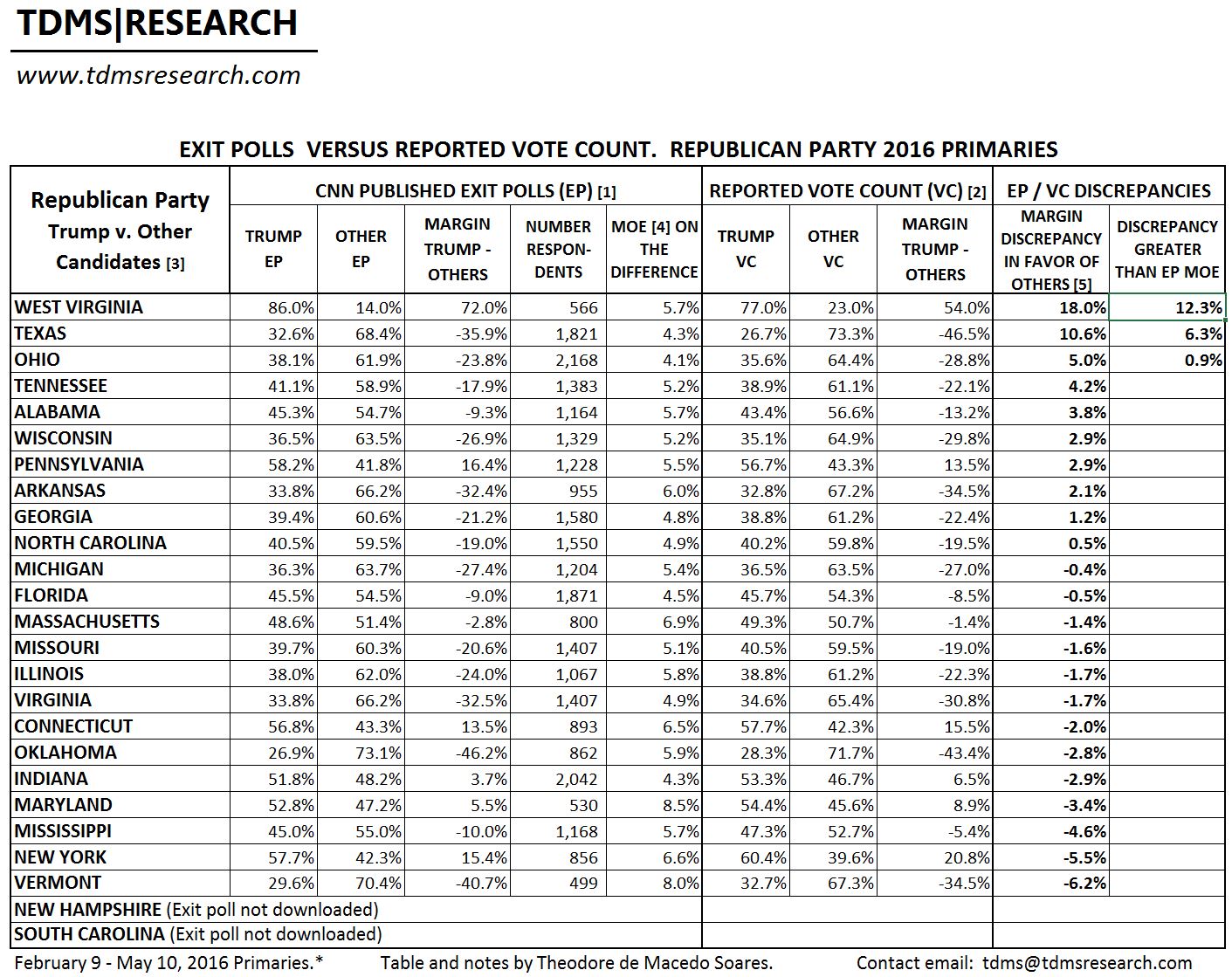by Theodore de Macedo Soares.
Republican Party 2016 primaries. This table, Republican Party Table 1, compares candidate Trump’s results with the combined results of the competing candidates applying the standard margin of error calculations.
Table show the discrepancies between exit poll results and the unverified computer vote counts. Discrepancies that exceed the margin of error (MOE) of the exit polls are shown in the last column. The MOE applied is the standard formula used when the news media and others report survey results. This MOE only addresses the statistical sampling error associated with the size of the sample. As the size of the sample increases, the margin of error decreases.
Presentation of exit poll results are often criticized because the standard MOE formula does not address all the other possible errors common to all surveys. The accompanying table, Republican Party Table 2, addresses this criticism by taking into account the total survey error (TSE) calculated by comparing 106 exit poll results for the main candidates in the Republican Party primaries with the official vote counts.
Some analysts have applied a MOE increased by 30% to exit poll surveys to compensate for their design effect. This increase, ostensibly based on Merkle and Edelman (2000),* is questionable. Merkle and Edelman based their findings on the 1996 Presidential race exit polls that do not necessarily apply to exit polls conducted 17 years later by a different polling firm. Additionally, no details or calculations were published to support their design effect findings. Coincidentally, the total survey error calculated for the 2016 primaries increases the standard MOE by 32% which is very close to the 30% increase in the MOE applied by other analysts.
* Merkle, D.M. and M. Edelman. 2000. A review of the 1996 voter news service exit polls from a total survey error perspective. In (P.J. Lavrakas and M. Traugott, eds.) Election polls, the news media, and democracy. Chatham House, New York.

[1] Exit polls (EP) conducted by Edison Research and published by CNN shortly after the closing of polls for the state and downloaded by TdMS. Copies are available. Exit poll results are derived from the gender category–the proportion of men and women voting for each candidate. As these first published exit polls were altered/adjusted to conform to the unverified computer vote counts, the discrepancies noted above were adjusted to near zero in the final EPs.
[2] New York Times reported 100% vote count (99% for NY, CT, MD, PA Primaries 6/12/2016). http://www.nytimes.com/elections/results
[3] This table compares candidate Trump’s results with the combined results of the competing candidates.
[4] Margin of Error (MOE) is for the differences between the two candidates (at 95% confidence interval). This MOE is about double the usual MoE for each candidate. MOE calculated according to: Franklin, C. The ‘Margin of Error’ for Differences in Polls. University of Wisconsin, Madison, Wisconsin. October 2002, revised February 2007. Available at: https://abcnews.go.com/images/PollingUnit/MOEFranklin.pdf
[5] In contrast to the Democratic Party primaries results, where 22 of 25 EP/VC discrepancies favored Clinton the discrepancies in the Republican Party primaries were more balanced–for and against Trump–which is the expected result of an impartial vote count and random errors in the exit poll. Two states, West Virginia and Texas exhibited very large discrepancies, far exceeding the MOE of the exit polls. In West Virginia Trump’s vote count at 9% less than predicted by the exit poll plus a 5.3% increase in the vote totals of minor candidates plus a 2.7% increase in the vote totals for Kasich compared to the exit poll predictions formed the bulk of the large 18% discrepancy. In Texas, Cruz’s home state, Trump’s vote count at 5.8% less than predicted by the exit polls plus Cruz’s 4.7% increase in the vote count than predicted by the exit polls comprised the bulk of the discrepancies.
* According to personal communication on May 23, 2016 from Mr. Lenski, Executive Vice President of Edison Research, as the National Election Pool (NEP) consisting of ABC, CBS, FOX, NBC, and the Associated Press did not provide funding to conduct exit polls for the remaining primaries, they did not occur. The remaining primaries for which no exit polls were conducted:
May 24 – Republican Party primary: Washington. June 5 – Democratic Party primary: Puerto Rico
June 7 – Democratic and Republican Party primaries: California, New Jersey, New Mexico, South Dakota, and Montana
June 14 – Democratic Party primary: District of Columbia
[…] hardened skeptics. While the exit poll results were consistently accurate throughout nearly all of the Republican primaries, they were wildly and broadly inaccurate in the Democratic primaries, exhibiting a pervasive […]
[…] voting represented about 40% of the votes, this year it will exceed 60%. The fact that for the 2016 Republican Party primaries the vote counts matched the exit polls—with most misses within the margin of error for the polls […]